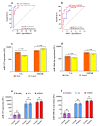Nourin-Dependent miR-137 and miR-106b: Novel Early Inflammatory Diagnostic Biomarkers for Unstable Angina Patients
- PMID: 33670982
- PMCID: PMC7997347
- DOI: 10.3390/biom11030368
Nourin-Dependent miR-137 and miR-106b: Novel Early Inflammatory Diagnostic Biomarkers for Unstable Angina Patients
Abstract
Background: Currently, no blood biomarkers exist that can diagnose unstable angina (UA) patients. Nourin is an early inflammatory mediator rapidly released within 5 min by reversible ischemic myocardium, and if ischemia persists, it is also released by necrosis. Nourin is elevated in acute coronary syndrome (ACS) patients but not in symptomatic noncardiac and healthy subjects. Recently, circulating microRNAs (miRNAs) have been established as markers of disease, including cardiac injury and inflammation.
Objectives: To profile and validate the potential diagnostic value of Nourin-dependent miR-137 (marker of cell damage) and miR-106b-5p (marker of inflammation) as early biomarkers in suspected UA patients and to investigate the association of their target and regulating genes.
Methods: Using Nourin amino acid sequence, an integrated bioinformatics analysis was conducted. Analysis indicated that Nourin is a direct target for miR-137 and miR-106b-5p in myocardial ischemic injury. Two linked molecular networks of lncRNA/miRNAs/mRNAs were also retrieved, including CTB89H12.4/miR-137/FTHL-17 and CTB89H12.4/miR-106b-5p/ANAPC11. Gene expression profiling was assessed in serum samples collected at presentation to an emergency department (ED) from: (1) UA patients (n = 30) (confirmed by invasive coronary angiography with stenosis greater than 50% and troponin level below the clinical decision limit); (2) patients with acute ST elevation myocardial infarction (STEMI) (n = 16) (confirmed by persistent ST-segment changes and elevated troponin level); and 3) healthy subjects (n = 16).
Results: Gene expression profiles showed that miR-137 and miR-106b-5p were significantly upregulated by 1382-fold and 192-fold in UA compared to healthy, and by 2.5-fold and 4.6-fold in STEMI compared to UA, respectively. Healthy subjects showed minimal expression profile. Receiver operator characteristics (ROC) analysis revealed that the two miRNAs were sensitive and specific biomarkers for assessment of UA and STEMI patients. Additionally, Spearman's correlation analysis revealed a significant association of miRNAs with the associated mRNA targets and the regulating lncRNA.
Conclusions: Nourin-dependent gene expression of miR-137 and miR-106b-5p are novel blood-based biomarkers that can diagnose UA and STEMI patients at presentation and stratify severity of myocardial ischemia, with higher expression in STEMI compared to UA. Early diagnosis of suspected UA patients using the novel Nourin biomarkers is key for initiating guideline-based therapy that improves patients' health outcomes.
Keywords: Nourin; acute coronary syndromes; inflammatory diagnostic biomarkers; miRNAs; reversible myocardial ischemia; unstable angina.
Conflict of interest statement
S.A.E. is the founder of Nour Heart, Inc. R.H.C. reports receiving a research grant from Spingotech Diagnostics, Roche Diagnostics, Siemens Diagnostics, Becton Dickinson. U.K. and D.L.K. are founders of Cell and Molecular Tissue Engineering, LLC. The other authors have no conflicts of interest to disclose.
Figures




Similar articles
-
Nourin-Associated miRNAs: Novel Inflammatory Monitoring Markers for Cyclocreatine Phosphate Therapy in Heart Failure.Int J Mol Sci. 2021 Mar 30;22(7):3575. doi: 10.3390/ijms22073575. Int J Mol Sci. 2021. PMID: 33808213 Free PMC article.
-
Integrated Bioinformatics Analysis Confirms the Diagnostic Value of Nourin-Dependent miR-137 and miR-106b in Unstable Angina Patients.Int J Mol Sci. 2023 Sep 30;24(19):14783. doi: 10.3390/ijms241914783. Int J Mol Sci. 2023. PMID: 37834231 Free PMC article.
-
Nourin-Dependent miR-137 and miR-106b: Novel Biomarkers for Early Diagnosis of Myocardial Ischemia in Coronary Artery Disease Patients.Diagnostics (Basel). 2021 Apr 14;11(4):703. doi: 10.3390/diagnostics11040703. Diagnostics (Basel). 2021. PMID: 33919942 Free PMC article.
-
Novel biomarkers in the diagnosis of acute coronary syndromes: the role of circulating miRNAs.Expert Rev Cardiovasc Ther. 2014 Sep;12(9):1119-24. doi: 10.1586/14779072.2014.953483. Expert Rev Cardiovasc Ther. 2014. PMID: 25160996 Review.
-
Copeptin, miRNA-208, and miRNA-499 as New Biomarkers for Early Detection of Acute Coronary Syndrome.Appl Biochem Biotechnol. 2022 Mar;194(3):1193-1205. doi: 10.1007/s12010-021-03695-6. Epub 2021 Oct 12. Appl Biochem Biotechnol. 2022. PMID: 34637111 Review.
Cited by
-
miR-30a-5p attenuates hypoxia/reoxygenation-induced cardiomyocyte apoptosis by regulating PTEN protein expression and activating PI3K/Akt signaling pathway.BMC Cardiovasc Disord. 2024 May 5;24(1):236. doi: 10.1186/s12872-024-03900-4. BMC Cardiovasc Disord. 2024. PMID: 38705985 Free PMC article.
-
Nourin-Associated miRNAs: Novel Inflammatory Monitoring Markers for Cyclocreatine Phosphate Therapy in Heart Failure.Int J Mol Sci. 2021 Mar 30;22(7):3575. doi: 10.3390/ijms22073575. Int J Mol Sci. 2021. PMID: 33808213 Free PMC article.
-
Expression level of miR-146a is associated with the coronary lesion severity and clinical prognosis in patients with unstable angina pectoris.Int J Cardiol Cardiovasc Risk Prev. 2025 Jan 10;24:200367. doi: 10.1016/j.ijcrp.2025.200367. eCollection 2025 Mar. Int J Cardiol Cardiovasc Risk Prev. 2025. PMID: 39872631 Free PMC article.
-
LncRNA GAS5/miR-137 Is a Hypoxia-Responsive Axis Involved in Cardiac Arrest and Cardiopulmonary Cerebral Resuscitation.Front Immunol. 2022 Jan 11;12:790750. doi: 10.3389/fimmu.2021.790750. eCollection 2021. Front Immunol. 2022. PMID: 35087519 Free PMC article.
-
Circulating miRNA-106b-5p As a Potential Biomarker for Coronary Artery Disease.Int J Mol Cell Med. 2024;13(3):325-336. doi: 10.22088/IJMCM.BUMS.13.3.325. Int J Mol Cell Med. 2024. PMID: 39493512 Free PMC article.
References
-
- Collet J.-P., Thiele H., Barbato E., Barthélémy O., Bauersachs J., Bhatt D.L., Dendale P., Dorobantu M., Edvardsen T., Folliguet T., et al. 2020 ESC Guidelines for the management of acute coronary syndromes in patients presenting without persistent ST-segment elevationThe Task Force for the management of acute coronary syndromes in patients presenting without persistent ST-segment elevation of the European Society of Cardiology (ESC) Eur. Heart J. 2020:1–79. doi: 10.1093/eurheartj/ehaa575. - DOI
-
- Jakimov T., Mrdović I., Filipović B., Zdravković M., Djoković A., Hinić S., Milić N., Filipović B. Comparison of RISK-PCI, GRACE, TIMI risk scores for prediction of major adverse cardiac events in patients with acute coronary syndrome. Croat. Med. J. 2017;58:406–415. doi: 10.3325/cmj.2017.58.406. - DOI - PMC - PubMed
-
- Singh T., Bing R., Dweck M.R., van Beek E.J.R., Mills N.L., Williams M.C., Villines T.C., Newby D.E., Adamson P.D. Exercise Electrocardiography and Computed Tomography Coronary Angiography for Patients With Suspected Stable Angina Pectoris: A Post Hoc Analysis of the Randomized SCOT-HEART Trial. JAMA Cardiol. 2020;5:920–928. doi: 10.1001/jamacardio.2020.1567. - DOI - PMC - PubMed
Publication types
MeSH terms
Substances
LinkOut - more resources
Full Text Sources
Other Literature Sources

